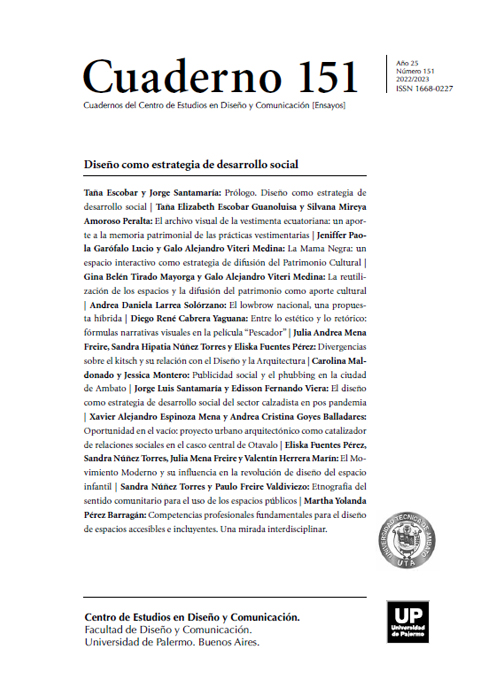La Mama Negra: un espacio interactivo como estrategia de difusión del Patrimonio Cultural
Abstract
The management of cultural diffusion spaces is deficient in the museographic area and they are no longer the main agents for the diffusion, legitimization and appropriation of the Intangible Cultural Heritage. The main objective of museums in the 21st century is focused on the real integration of the public, trying to relate real experiences through the direct interaction of the user. Currently, new channels and digital means of dissemination have been used as a strategy for the transmission of information, one of them being technology, which has played an important role in museums in the historical and cultural area, improving the quality of the visitors’ experience and making them more accessible. This article addresses the issue of the application of interactive spaces as a strategy for the dissemination of Intangible Cultural Heritage, which, through the interior design, media and technological tools and the study of the popular festival, is able to generate a space through which the cultural identity is embodied, from and for its citizens, strengthening the current cultural legacy and that subsequently can be transferred to other audiences. This work proposes, through the deductive method and a qualitative and quantitative research approach, to collect information through bibliographic research, surveys and interviews that will allow us to evaluate, measure and determine the important elements to reflect and capture the cultural identity in a physical space.
References
Alonso Hernández, N. E. (2011). Un museo para todos: el diseño museográfico en función de los visitantes. Plaza y Valdés, S.A. de C.V. https://elibro.net/es/ereader/uta/39043?page=1
Baca, Karolys, Ubilla Freire, J., (2007). Lenguaje popular de la fiesta de la Mama Negra, Mama Negra. Impresora Charito, Latacunga.
Broncano, F. (2009). La melancolía del ciborg. Barcelona: Herder.
Cárate, S. (2011). “Dinámicas simbólicas en una fiesta popular andina. El caso de la Mama Negra de Latacunga”. Tesis. Quito- Ecuador. http://repositorio.puce.edu.ec/handle/22000/3336.
Costa, J., (2003). Diseñar para los ojos. (Vol. 1). Universidad de Medellin.
Cuetos, M. P. G. (2012). El patrimonio cultural. Conceptos básicos (Vol. 207). Universidad de Zaragoza.
Dever Restrepo, P. (2010). Manual básico de montaje museográfico.
Freire, L. (2007). En S. Cerate, La capitanía de la Mama Negra o Santísima Tragedia.
Guerrero, P. (2004). Usurpación simbólica, identidad y poder: la fiesta como escenario de lucha de sentidos Quito: Editorial Abya Yala. http://hdl.handle.net/10644/235
Karolys, M. (2005). La Mama Negra. En Municipio de Latacunga, Latacunga y la Mama Negra. Quito, Ecuador: Equinoccio.
KGR proyectos, (2020). Museo del Carnaval de Barranquilla. Plataforma Arquitectura. https://www.plataformaarquitectura.cl/cl/945320/museo-del-carnaval-de-barranquilla-kgr-proyectos> ISSN 0719-8914
La wiphala, emblema sagarado de los pueblos andinos, (20 de ferbrero del 2019). Diario El Telégrafo.
Molano, O. L. (2007). Identidad cultural un concepto que evoluciona. Revista opera, (7), 69-84.
Navas, M., (1988). La Mama Negra. Quito - Ecuador.
Paredes, E. (2005). Mama Negra. En M. d. Latacunga y la Mama Negra. Quito, Ecuador: Equinoccio.
Paredes, E., (2004). Mama Negra Novembrina 1963-2004. Latacunga: Imprenta Gráficos Unidos.
Peñalba, J. L. (2005). Evolución del concepto y de la significación social del patrimonio cultural. Arte, Individuo y Sociedad. 117 - 183. https://revistas.ucm.es/index.php/ARIS/article/view/ARIS0505110177A
Pereira Valarezo, J. (2019). La fiesta popular tradicional del Ecuador. FLACSO. https://elibro.net/es/ereader/uta/80246?page=7
Pereira Valarezo, J. (2017). La fiesta popular tradicional del Ecuador. FLACSO. https://elibro.net/es/ereader/uta/80246?page=7
Proaño, L. O. (1993). Nuestra Señora de la Merced en la colonia y en la República del Ecuador. Quito.
Rico, J. C. (2006). Manual práctico de museología, museografía y técnicas expositivas. Sílex ediciones.
Schneider, Daniela (2007). La Mama Negra - ¿símbolo de la multiculturalidad ecuatoriana? Indiana. ISSN: 0341-8642. https://www.redalyc.org/articulo.oa?id=247016522007
Wagensberg, J. (1994). A favor del conocimiento científico (los nuevos museos). Alambique, 18, 85-99.
Los autores/as que publiquen en esta revista ceden los derechos de autor y de publicación a "Cuadernos del Centro de Estudios de Diseño y Comunicación", Aceptando el registro de su trabajo bajo una licencia de atribución de Creative Commons, que permite a terceros utilizar lo publicado siempre que de el crédito pertinente a los autores y a esta revista.


